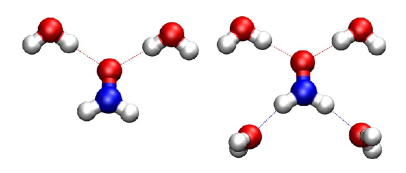-
Modeling solvent effects on electron spin resonance hyperfine couplings by frozen-density embedding
J. Neugebauer, M.J. Louwerse, P. Belanzoni, T.A. Wesolowski and E.J. Baerends
Journal of Chemical Physics, 123 (2005), p114101


DOI:10.1063/1.2033749 | unige:3619 | Abstract | Article HTML | Article PDF | Article PS (gzipped)

In this study, we investigate the performance of the frozen-density embedding scheme within density-functional theory [ J. Phys. Chem. 97, 8050 (1993) ] to model the solvent effects on the electron-spin-resonance hyperfine coupling constants (hfcc’s) of the H2NO molecule. The hfcc’s for this molecule depend critically on the out-of-plane bending angle of the NO bond from the molecular plane. Therefore, solvent effects can have an influence on both the electronic structure for a given configuration of solute and solvent molecules and on the probability for different solute (plus solvent) structures compared to the gas phase. For an accurate modeling of dynamic effects in solution, we employ the Car-Parrinello molecular-dynamics (CPMD) approach. A first-principles-based Monte Carlo scheme is used for the gas-phase simulation, in order to avoid problems in the thermal equilibration for this small molecule. Calculations of small H2NO-water clusters show that microsolvation effects of water molecules due to hydrogen bonding can be reproduced by frozen-density embedding calculations. Even simple sum-of-molecular-densities approaches for the frozen density lead to good results. This allows us to include also bulk solvent effects by performing frozen-density calculations with many explicit water molecules for snapshots from the CPMD simulation. The electronic effect of the solvent at a given structure is reproduced by the frozen-density embedding. Dynamic structural effects in solution are found to be similar to the gas phase. But the small differences in the average structures still induce significant changes in the computed shifts due to the strong dependence of the hyperfine coupling constants on the out-of-plane bending angle.